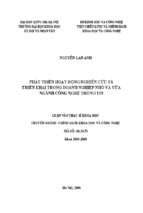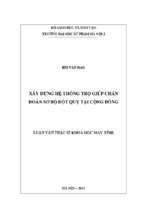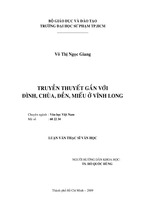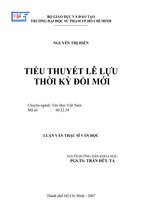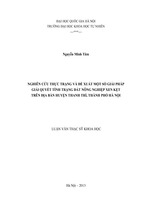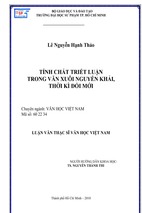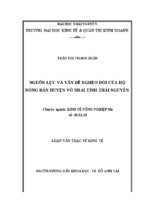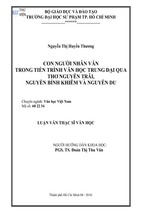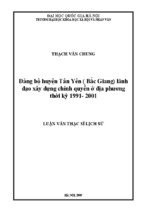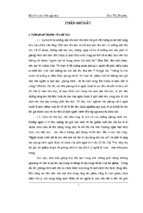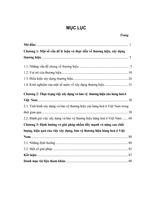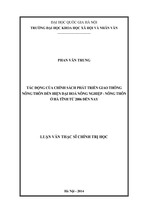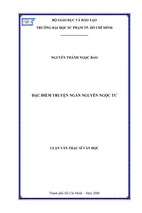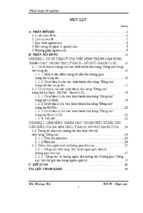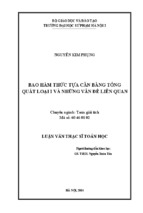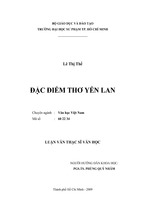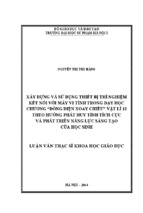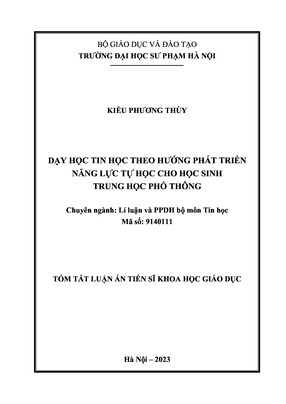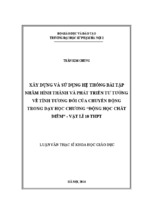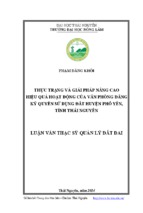Infobesity – Information obesity, which means information overload, reflects exactly what people are experiencing in this era of technologies. With technological advancements, people become indecisive when reading different writings written by different people with different viewpoints but about the same issue. Gradually, people’s critical mind gets eroded with the words they read. Being aware of the information trap, it is of the utmost importance for freshmen in the Fast-track program of Faculty of English Language Teacher Education (FELTE) – University of Languages and International Studies (ULIS) to avoid being baited by developing critical reading proficiency.
VIETNAM NATIONAL UNIVERSITY, HANOI
UNIVERSITY OF LANGUAGES & INTERNATIONAL STUDIES
FACULTY OF ENGLISH LANGUAGE TEACHER EDUCATION
GRADUATION PAPER
THE APPLICATION OF CRITICAL READING IN
READING LOGS ASSIGNMENT AS PERCEIVED BY
FRESHMEN OF THE FAST-TRACK DIVISION,
FELTE, ULIS, VNU
Supervisor: Phạm Thanh Thủy (M.Ed)
Student: Nguyễn Phương Liên
Course: QH2015.F1.E2
Hanoi – 2019
Signature of Approval:
ĐẠI HỌC QUỐC GIA HÀ NỘI
TRƯỜNG ĐẠI HỌC NGOẠI NGỮ
KHOA SƯ PHẠM TIẾNG ANH
KHÓA LUẬN TỐT NGHIỆP
NGHIÊN CỨU VỀ VIỆC ÁP DỤNG KỸ NĂNG ĐỌC
PHÊ PHÁN KHI LÀM READING LOGS CỦA SINH
VIÊN NĂM NHẤT HỆ CHẤT LƯỢNG CAO, KHOA SƯ
PHẠM TIẾNG ANH, TRƯỜNG ĐẠI HỌC NGOẠI NGỮ,
ĐẠI HỌC QUỐC GIA HÀ NỘI
Giáo viên hướng dẫn: Ths. Phạm Thanh Thủy
Sinh viên: Nguyễn Phương Liên
Khóa: QH2015.F1.E2
HÀ NỘI – 2019
ACCEPTANCE PAGE
I hereby state that I: Nguyen Phuong Lien, class QH2015.F1.E2, being a candidate for
the degree of Bachelor of Arts (Honours Programme) accept the requirements of the
College relating to the retention and use of Bachelor’s Graduation Paper deposited in
the library.
In terms of these conditions, I agree that the origin of my paper deposited in the library
should be accessible for the purposes of study and research, in accordance with the
normal conditions established by the librarian for the care, loan or reproduction of the
paper.
Signature
Date
ACKNOWLEDGEMENTS
To be honest, my journey to complete this graduation paper was long and arduous.
However, after all, I realized that I learnt more than what was written in this paper. This
part is dedicated to the wonderful people, without whom this paper would have never
been completed.
First of all, I would like to show my deepest gratitude to my supervisor, Ms. Pham
Thanh Thuy. Her attentive guide and tremendous support in 6 continuous months have
been the motivation for me to complete this research paper. Without her, I could not
have had this paper completed.
Second, I would like to express my appreciation to my brothers and sisters in classes
18E1, 18E2 and 18E20, who not only helped me during the data collection process but
also sent me continuous support. They are Hai Anh, Huy Hoang, and Bui Ha. Besides,
I would like to say thank you to 72 participants for their time and effort taking part in
this research.
Third, I would like to extend my sincere gratitude to my seniors – Ms. Nguyen Phuc
Cam Nhi and Mr. Nguyen Vu Quoc Duy for becoming my second supervisors by giving
me precious advice and motivating me in the hardest time.
I want to say ‘thank you’ to my beloved family for the endless love and support in every
moment of my life. Thank you, my precious friends, including 9A10 girls, Benzen girls,
Cam Tu, Thu Hang and 15E2 buddies. You cried with me, you smiled with me, you
stayed up all night with me to finish this paper.
Finally, thank you, my dearest Ong Seongwu, for your exceptionally inspiring support
for me.
i
ABSTRACT
Infobesity – Information obesity, which means information overload, reflects exactly
what people are experiencing in this era of technologies. With technological
advancements, people become indecisive when reading different writings written by
different people with different viewpoints but about the same issue. Gradually, people’s
critical mind gets eroded with the words they read. Being aware of the information trap,
it is of the utmost importance for freshmen in the Fast-track program of Faculty of
English Language Teacher Education (FELTE) – University of Languages and
International Studies (ULIS) to avoid being baited by developing critical reading
proficiency.
With an aim to foster and improve students’ critical reading proficiency, the Reading
Logs assignment has been introduced to these freshmen in their very first semester. In
this paper, the researcher aims to investigate into the application of critical reading skills
during the process of doing Reading Logs as well as the critical reading proficiency
achieved by students after their completing the Reading Logs assignment. To achieve
the target, a combination of qualitative and quantitative methods was adopted for data
collection and analysis. Both questionnaires and interviews were utilized to collect
quantitative and qualitative data, which then would be analyzed by statistical and
thematic data analytic techniques.
Based on the framework proposed by Li (2010), the results reveal that students could
exploit skills of different levels namely approaching skills, analyzing skills, meaning
discovering skills, and evaluating skills. Moreover, after the Reading Logs assignment,
they could achieve a certain level of critical reading proficiency. However, there still
existed gaps to improve in order to reinforce students’ critical reading proficiency
through this assignment. In this research, some suggestions would also be offered for
the betterment of the assignment.
ii
TABLE OF CONTENTS
Acknowledgement ........................................................................................................... i
Abstract ........................................................................................................................... ii
List of figures, tables and abbreviations ......................................................................... v
CHAPTER 1: INTRODUCTION ............................................................................... 1
1. Rationale of the research ............................................................................................ 1
2. Objectives of the research & research questions ........................................................ 2
3. Scope of the research .................................................................................................. 2
4. Significance of the research ........................................................................................ 2
5. Organization of the research ...................................................................................... 3
CHAPTER 2: LITERATURE REVIEW ................................................................... 4
1. The concept of critical reading ................................................................................... 4
2. Critical reading proficiency framework ..................................................................... 6
3. Reading Logs Assignment ........................................................................................ 10
4. Research gap ............................................................................................................. 10
CHAPTER 3: METHODOLOGY ............................................................................ 12
1. Research methodology ............................................................................................. 12
2. Participants ............................................................................................................... 12
3. Data collection instruments and procedure ............................................................. 13
3.1. Data collection instruments .............................................................................. 13
iii
3.1.1. Questionnaire .......................................................................................... 13
3.1.2. Interview ................................................................................................. 21
3.2. Data collection procedure ................................................................................ 21
4. Data analysis method and procedure ....................................................................... 22
4.1. Quantitative analysis strategies......................................................................... 22
4.2. Qualitative analysis strategies ........................................................................... 23
CHAPTER 4: FINDINGS AND DISCUSSION ...................................................... 24
1. Data analysis ............................................................................................................. 24
2. Findings and discussion ............................................................................................ 43
3. Pedagogical implications and suggestions ............................................................... 47
CHAPTER 5: CONCLUSION .................................................................................. 49
1. Summary of major findings ...................................................................................... 49
2. Limitations and suggestions for further studies........................................................ 49
References
Appendices
iv
List of Figures
1. The degree of following guiding questions among Fast-track
25
freshmen while reading for Reading Logs assignment
2. Average rate of Fast-track freshmen in each level of CRP
26
inventory
3. The performance of Fast-track Freshmen at Level 1 of CRP
27
inventory
4. The performance of Fast-track Freshmen at Level 2 of CRP
29
inventory
5. The performance of Fast-track Freshmen at Level 3 of CRP
30
inventory
6. The performance of word determination among Fast-track
31
freshmen while reading texts
7. The performance of Fast-track Freshmen at Level 4 of CRP
33
inventory
8. The performance of Fast-track Freshmen at Level 5 of CRP
35
inventory
9. The average rating of Fast-track freshmen on each level of CRP
36
based on Four-level Framework of CRP developed by Li (2010)
10. The rating of Fast-track freshmen on Structure Analysis Level
37
based on Four-level Framework of CRP developed by Li (2010)
11. The rating of Fast-track freshmen on Rhetoric Analysis Level
39
based on Four-level Framework of CRP developed by Li (2010)
12. The rating of Fast-track freshmen on Social Relevance Level
40
based on Four-level Framework of CRP developed by Li (2010)
13. The rating of Fast-track freshmen on Holistic Evaluation Level
based on Four-level Framework of CRP developed by Li (2010)
v
42
List of Tables
1. Summary of definitions of critical reading (Li, 2010)
4
2. A Four-level Framework of CRP (Li, 2010)
7
3. Table of Critical Reading Proficiency inventory (Li, 2010)
14
4. Table of CRP inventory divided into levels based on Li’s
18
framework
List of Abbreviations
CR
Critical Reading
CRP
Critical Reading Proficiency
CLAST
College Level Academic Skills Test
FELTE
Faculty of English Language Teacher Education
ULIS
University of Languages and International Studies
VNU
Vietnam National University
vi
CHAPTER 1: INTRODUCTION
1. Rationale of the research
In the era of information and communication technologies, people are offered to get
access to an overwhelmingly huge amount of information without paying much cost or
putting in much effort (Rev, 2014). However, not all the available information is
completely true or agreed on by everyone. About one issue, there can be countless
opinions which are backed up by their own bases. Readers are free to take a side or even
offer another opinion of their own. Therefore, this availability and freedom pose a need
for critical reading from readers so that they will not go with or be controlled easily by
anyone’s words. It is not only reading or comprehending a text. More than that, critical
reading means that people insert their personal perspectives and make “careful
evaluation, sound judgment and reasoning powers” (Millan, 1995: 218).
It is of a more significant need for students of Faculty of English Language Teacher
Education, University of Languages and International Studies, Vietnam National
University (hereafter referred to as FELTE, ULIS, VNU) to demonstrate critical reading
in the context of studying to become the English language teachers. However, according
to Vu (2015), only a low proportion of FELTE, ULIS students can demonstrate
appropriate critical reading skills at the basic level.
Being aware of that, the Reading Logs assignment has been designed for the Fast-track
freshmen of FELTE, ULIS. As clearly stated in the Course Guide 1A* (Updated in
August 2018), the Reading Logs assignment offered students a chance to read several
texts of different genres and styles. The assignment consisted of three entries, for each
of which, students were required to read and analyze one text of about 400-500 words
in groups. After group discussions, students were expected to share their reading logs
with the whole class within the designated weeks. At the beginning of the semester, a
list of guiding questions was provided for students to stimulate their critical reading
skills in the reading procedure. Although there were researches which studied the
promotion of critical reading in general and the effectiveness of critical reading
development in certain particular projects, there was no relevant research about Reading
Logs assignment and few chances were offered to students to reflect on their critical
1
reading proficiency. Also, the current marking criteria could hardly measure the
proficiency to read critically of learners. Those are the gaps that need fulfilling through
this research.
2. Objectives of the research & research questions
This study focuses on two main objectives: (1) Analyze students’ ability to utilize
critical reading skills during their time doing Reading Logs, specifically what skills and
what skill levels they exploited; (2) Assess student’s critical reading proficiency after
doing Reading Logs based on their self-reflections. To accomplish these objectives, a
combination of qualitative and quantitative researches was employed, aiming at
answering two research questions:
1. What critical reading skills did FELTE, ULIS Fast-track freshmen apply when they
read a text for Reading Logs assignment?
2. On a Four-level framework of Critical Reading Proficiency developed by Li in 2010,
to what level can Reading Logs promote FELTE ULIS Fast-track freshmen’s critical
reading proficiency as perceived by ULIS Fast-track freshmen?
Based on the findings from these two questions, some pedagogical implications were
expected to be contributed to the teaching and learning curriculum of Fast-track
program in FELTE, ULIS.
3. Scope of the research
The research aims to study the application of critical reading skills among Fast-track
freshmen in FELTE, ULIS. Therefore, the participants of this research are students from
three QH2018 Fast-track classes, who have just finished their Reading Logs in the
previous semester.
4. Significance of the research
Being aware of the gap to bridge, this research aims to study the Fast-track freshmen’s
application of critical reading skills and evaluate how far they can promote the skills
during their reading procedure based on a framework to assess critical reading
proficiency developed by Li (2010). Regarding the significance of this research, both
2
learners and teachers can benefit from it. For learners, they can find the flaws in their
previous reading strategies and make some adjustments to improve. For the teachers or
curriculum developers, it is a chance to review the effectiveness of the assignment in
promoting critical reading skills and consider the ways to improve the assignment.
5. Organization of the research
This research paper is divided into five chapters namely Introduction, Literature Review,
Methodology, Findings and Discussion, and Conclusion. Each part plays a distinctive
role to accomplish the objectives of this research.
In the first chapter, which is the Introduction, the rationale, objectives, scope and
significance of the research are clarified, giving an overview of this research paper.
The next two chapters, which are the Literature Review and Methodology, play
important roles in introducing the development of the research. In the Literature Review
chapter, the theoretical bases of the research are proposed. Meanwhile, the
Methodology chapter brings a closer look into the data collection methods as well as
the data analyzing strategies utilized in the study.
All the data analysis results and discussion are presented in the fourth chapter called
Findings & Discussion. Moreover, the pedagogical implications derived from the
results can also be found in this chapter.
Last but not least, the conclusion chapter covers the summary of major findings and
points out the limitations of this research. Some recommendations for further studies
are also included in this chapter.
3
CHAPTER 2: LITERATURE REVIEW
In this chapter, not only are the key literature concepts and definitions presented, but
the correlation of this research with existing works is also be located.
1. The concept of critical reading
There have been several pieces of research regarding the topic of critical reading. Li
(2010) made a summary of different ways to define “critical reading” over the 30-year
period as follows.
Author(s)
Main points of the definition
Year
Poulson&
It asks for keeping an open mind, retaining a
2004
Wallace
conditional willingness to be convinced, etc.
Schwegler
Critical reading is active reading. It involves some
2004
activity on the reader’s part.
Pirozzi
It is high-level comprehension of written material
2003
requiring interpretation and evaluation skills.
Bean, et al.
Critical reading, like writing, is an active process of
2002
composing.
Garrigus
It requires to explain figurative language and to
2002
identify basic logical fallacies and emotional appeals.
Milan
It requires to maintain objectivity and not to allow
1995
expectations, biases, or personal prejudices to
interfere with understanding.
Phillips
& It is more than the ability to understand the explicit
Sotiriou
meaning of the passage. It involves application,
1992
analysis, evaluation and imagination.
Adams
It refers to distinguishing fact from opinion,
recognizing intent, attitude, and tone; recognizing
inferences and drawing conclusions.
4
1989
Clegg
It distinguishes between truth and distortion,
1988
information and propaganda, public policy and
personal prejudice.
Hancock
It requires to question, compare, and evaluate, to
1987
detect faulty logic and information… and then to
determine to accept or reject the information.
Maker
& Critical reading enables to size up the author’s
Lenier
arguments and to evaluate how well he supports them.
1986
A reader must think beyond what is stated and decide
what the author is trying to imply
Wassman
Paye
& Critical readers evaluate the writer’s information and
1985
draw conclusions of their own.
Raygor
& It requires to distinguishes among humor, satire,
Raygor
sarcasm, irony, and straightforward writing; to
1985
recognize implicit assumptions or inferences the
author is making, etc.
Spache
& It is the ability to read with analysis and judgment.
1984
Berg
Hafner
It is a thinking process that is improved by way of
1974
using language more constructively and clarifying
concepts through discussion and questioning.
Table 1. Summary of definitions of critical reading (Li, 2010)
All definitions have their own merits. This research eventually followed Spache’s and
Berg’s definition in 1984 for the fact that it could involve all ideologies from other
definitions. According to Spache and Berg (1984), ‘critical thinking is the ability to
read with analysis and judgement’ and it requires the combination of both writers’ and
readers’ ideologies, which may lead to a new way to avouch a problem or an idea in the
text.
Moving beyond the one-way communication by which writers can convey their
ideologies, attitudes or beliefs, and readers are meant to read and comprehend all of
5
those, an “interaction” is built up to connect the writers and readers’ perspectives. Some
of the ideas, attitudes and beliefs are synchronized, but there exist conflicts between
two ways of processing information: one coming from the reading materials and one
coming from the readers’ own experiences and ideologies. Therefore, reading with
analysis and judgment becomes vital to develop a high level of comprehension of the
written text. According to Pirozzi (2003), by analyzing carefully, readers are able to
make the decision on what is important in a text, whether one idea is a fact or writer’s
opinion and sometimes, readers make evaluation on both writers’ arguments and their
own reading of the texts.
2. Critical reading proficiency framework
Before approaching the critical reading proficiency assessing framework developed by
Li in 2010, it is necessary to clarify the variable levels of reading proficiency. Entailing
from Pirozzi’s definition (2003), being able to read a written text critically means that
the readers are more likely to comprehend the materials effectively. Lower than that, it
is categorized into literal comprehension skills.
As cited in Li’s research in 2010, the College Level Academic Skills Test (CLAST) has
classified different identities of literal comprehension and critical comprehension as
below:
Literal comprehension skills are divided into three areas.
1) Recognize the main idea/ideas in a passage
2) Identify supporting details
3) Determine meanings of words on the basis of context clues
Critical comprehension skills are divided into nine areas.
1) Recognize the author’s purpose
2) Identify the author’s overall organization pattern
3) Distinguish between statements of fact and statements of opinion
4) Detect bias in the passage or by the author
5) Recognize the author’s tone
6
6) Recognize explicit and implicit relationships within sentences
7) Recognize explicit and implicit relationships between sentences
8) Recognize valid/invalid arguments
9) Draw logical inferences and conclusions
(The CLAST website, 2007)
Based on the aforementioned categories of CLAST (2007) and checklists illustrating
the critical reading proficiency of Garrigus (2002), Bean (2002), Clegg (1988), Milan
(1995), Pirozzi (2003), Poulson & Wallace (2004), Raygor (1985), Li finally came up
with a hierarchical framework of critical reading proficiency consisting of four levels,
which is demonstrated in Table 2 below. This framework was chosen as the theory base
for this research.
Level
Description
At structure analysis Being able to guess words in context
level
Being able to summarize the main idea of the paragraph
Being able to summarize the main idea of the text
Being able to deduce sentence inference in context
Being able to separate major ideas from minor ideas
Being able to recognize developing methods
Being able to recognize the pattern of paragraph organization
Being able to distinguish facts and opinions
Being able to distinguish among opposing viewpoints
Being able to understand graphics
At rhetoric analysis Being able to recognize text register and genre
level
Being able to recognize the writer’s purposes
Being able to recognize the writer’s tone
Being able to evaluate word choice
Being able to recognize misused and abused language
Being able to explain figurative language
Being able to recognize and understand the rhetorical devices
7
Being able to uncover arguments
Being able to assess arguments
Being able to recognize appeals in arguments
Being able to recognize logical fallacies
Being able to recognize manipulative techniques
At social relevance Being able to relate the text to culture background
level
Being able to relate the text to event background
Being able to relate the text to author background
Being able to relate the text to situational context
Being able to relate the text to intertextual context
At
holistic Being able to read from critical distance
evaluation level
Being able to evaluate the text objectively
Being able to summarize the questions the text addresses
Being able to critique information presentation channels
Being able to examine the source
Being able to examine a text’s ideology
Being able to know who are the intended audience
Being able to understand how the author supports the thesis
with reason and evidence
Being able to perceive how the author hooks the intended
reader’s interest
Being able to read and then write a reasonable brief summary
of the text
Table 2. A Four-level Framework of CRP (Li, 2010)
Following this framework, a CRP test focus inventory was developed by Li in 2010.
However, this inventory did not provide the guiding questions like what the course
developers did in the Course Guide 1A*. Instead, it pointed out the details of each facet
in a component. More importantly, the inventory focused on critical reading skills rather
than the general guiding questions used in the current curriculum. To evaluate the CRP,
the inventory would perform better.
8
At the very first level, Li concentrated on the smallest unit of text which was paragraph.
In this level, readers were required to generate a general understanding of main ideas of
paragraphs and texts, viewpoints and the overall developing methods.
At a higher level called Rhetoric Analysis level, readers were expected to be able to
identify writers’ tone. Besides, readers could evaluate word choice, assess the
arguments, recognize the appeals and fallacies in terms of logic.
Moving beyond the meaning discovery in Rhetoric analysis, readers were expected to
be able to relate to backgrounds and contexts for better comprehension of the texts.
Finally, at the highest level of the framework, Li pointed out that at Holistic evaluation
level, readers should be able to understand the way writers supported his or her thesis,
the hooks he or she brought to readers as well as the ideology of the text. Entailing from
this ability, readers were expected to summarize the text in their own words and express
their personal points of view.
There existed other researches that studied and developed frameworks or criteria to
assess CRP. In 2014, Woodbeck introduced a holistic assessment rubric to evaluate
critical reading proficiency regarding four dimensions namely comprehension,
explication, reflection and application. However, this work of criteria was mostly
concerned about the ability to recognize and evaluate texts’ ideology and thesis
development, which meant several factors that might influence the ability to read
critically such as word usage, backgrounds and contexts. Of all the relevant researches,
Li’s framework was thorough and easy to follow. The requirements in each level were
clear and presented meticulously. Therefore, it was chosen to be the core theory base of
this research.
In general, all Li’s framework and inventory were built on general language teaching
and learning context. If being applied in the right way, it would be the ultimate tool for
teachers to evaluate learners’ critical reading proficiency more appropriately and
precisely.
9
3. Reading Logs Assignment
Reading Logs assignment was specially designed for Fast-track freshmen in Semester
1 of 1st year in FELTE, ULIS. Reading skills, writing skills and even speaking skills
were integrated into this assignment.
At the first stage of this assignment, students worked in groups of four and were
required to finish three entries in one semester. For each entry, groups were asked to
read a text of between 400-500 words and of required genres such as Fiction/Literature
reading, Informative reading and Argumentative reading. After the individual reading
process, a group discussion was conducted for students to share and analyze the text
together. Besides the group presentation, individual reports of students’ own analysis
were also submitted by the end of the entries.
Working on this assignment offered every student opportunity to closely read, analyze
and evaluate the texts based on the guiding steps and guiding questions. The guidance
is can be found in Appendix 1. The procedure is believed to follow the strategies to
develop students’ critical reading skills. Students’ compliance with the guidance of the
Course Guide 1A* (2018) and the Reading Logs assignment’s effectiveness in critical
reading promotion would be the main focus of this research.
4. Research gap
There have been a number of studies conducted on the development of critical reading
skills as well as its effectiveness. In the nature of FELTE - ULIS, the promotion of
critical reading was the focus in two pieces of research which were conducted by Vu
(2015) and by Nguyen and Tran (2016). While Vu conducted the research on the
exploitation of case-study on critical reading skills and his participants were the thirdyear Fast-track students in 2015, Nguyen and Tran (2016) focused on the effectiveness
of critical reading in one project called Scrapbook, which was specially designed for
the sophomores of Fast-track program.
In 2015, Vu mentioned the necessity to integrate reading and writing in the syllabus as
well as in the training curriculum in order to develop critical reading proficiency.
Scrapbook was one of the projects in the curriculum. According to the study of Nguyen
10
- Xem thêm -

